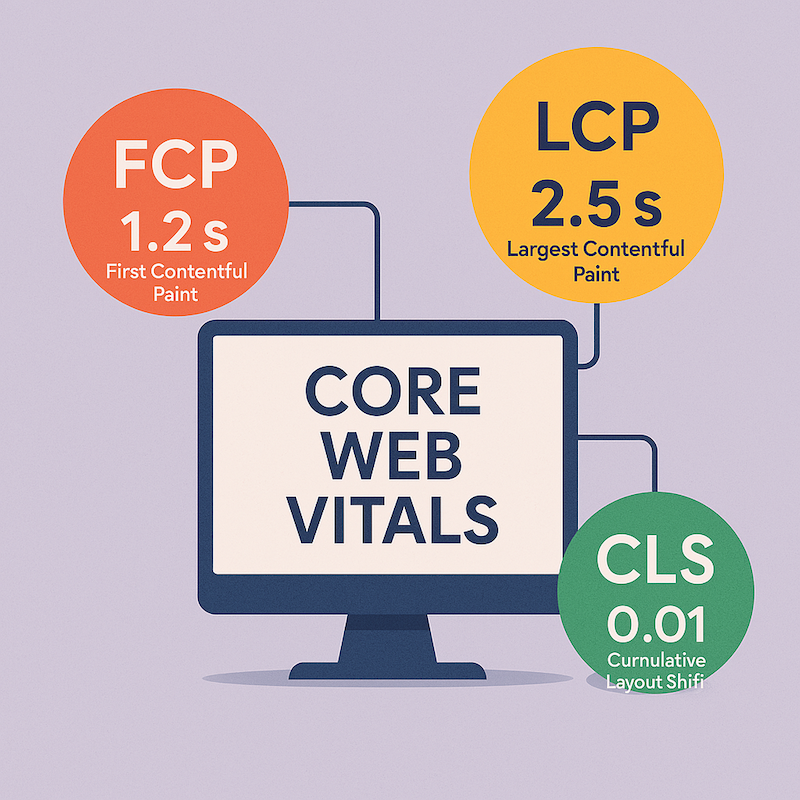In today’s digital landscape, user experience isn’t just an added bonus—it’s a ranking factor, especially regarding page load speed. With Google placing a growing emphasis on page experience, Core Web Vitals have emerged as essential metrics for measuring and optimizing user experiences. Whether you’re a web developer, digital marketer, or business owner, understanding and optimizing for these metrics is essential for boosting both your SEO performance and customer satisfaction.
Introduction to Core Web Vitals
Core Web Vitals are a set of specific factors, known as the three core web vitals, that Google considers important in a webpage’s overall user experience. They are part of the broader Page Experience Signals, which also include mobile-friendliness, HTTPS, and intrusive interstitial guidelines.
Page speed is a critical factor in web performance and user experience, particularly in relation to Google’s Core Web Vitals, which also consider user input latency.
Google’s Core Web Vitals focus on three key areas:
- Largest Contentful Paint (LCP): Measures loading performance.
- Cumulative Layout Shift (CLS): Assesses visual stability.
- Interaction to Next Paint (INP): Evaluates interactivity and responsiveness.
These user-centric metrics offer critical insights into how users perceive the performance of a webpage. Improving them doesn’t just lead to better rankings—it results in a smoother, faster, and more engaging browsing experience.
Understanding Core Web Vitals
Core Web Vitals serve as quantifiable indicators of a website’s usability and performance. As part of Google’s Web Vitals initiative, they help developers pinpoint real-world issues that impact the user journey.
The purpose of Core Web Vitals is to unify quality signals and streamline UX improvement efforts. Instead of abstract data, these metrics provide actionable insights that directly correlate to user satisfaction.
By analyzing these metrics, developers can make informed decisions about site structure, design choices, and performance improvements that genuinely matter to users—and to search engines.
Key Core Web Vitals Metrics
1. Largest Contentful Paint (LCP)
LCP measures how long it takes for the main content of a page, such as a hero image or a text block, to become visible. This could be a hero image, a block of text, or a key visual element. The target score is:
- Good: ≤ 2.5 seconds
- Needs Improvement: 2.6–4.0 seconds
- Poor: > 4.0 seconds
Slow-loading pages frustrate users and increase bounce rates. Optimizing for LCP ensures your website feels fast and efficient.
2. Cumulative Layout Shift (CLS)
CLS measures visual stability by quantifying how much the elements on a page shift unexpectedly. Common causes include dynamically injected content, images without dimensions, and late-loading fonts.
- Good: ≤ 0.1
- Needs Improvement: 0.1–0.25
- Poor: > 0.25
Layout shifts can cause users to accidentally click on the wrong elements, leading to frustration and inefficiency.
Minimizing CLS creates a smoother user experience by preventing frustrating layout jumps.
3. Interaction to Next Paint (INP)
INP replaces First Input Delay (FID) as the new standard for measuring interactivity. It captures the latency between user interaction (clicks, taps, keypresses) and the next visual response.
- Good: ≤ 200 milliseconds
- Needs Improvement: 201–500 ms
- Poor: > 500 ms
Improving INP ensures that users don’t experience lag, which can significantly reduce engagement and conversions.
4. First Input Delay (FID)
First Input Delay (FID) is a Core Web Vital that measures the time it takes for a web page to respond to a user’s first interaction, such as a click or tap. This metric is essential in evaluating the responsiveness of a website and ensuring that it provides a seamless user experience. FID is calculated by measuring the delay between the user’s first interaction and the browser’s response to that interaction.
To improve FID, web developers can focus on optimizing the main thread of their website, reducing the amount of JavaScript code, and minimizing the number of HTTP requests. By doing so, they can ensure that their website responds quickly to user interactions, providing a better overall user experience.
It’s worth noting that FID is being replaced by Interaction to Next Paint (INP) as a Core Web Vital. However, understanding FID is still crucial in diagnosing performance issues and improving the responsiveness of a website.
Measuring Core Web Vitals
The first step toward improving your Core Web Vitals is accurately measuring them. Fortunately, Google provides robust tools:
The Core Web Vitals report is a vital tool for site owners to measure their website’s performance and diagnose issues. Derived from real user data, it helps in identifying pages that need improvement and suggests using additional tools for more detailed performance analysis.
- PageSpeed Insights
- Lighthouse
- Chrome User Experience Report
PageSpeed Insights
This tool gives you both lab and field data about your Core Web Vitals. It also provides tailored recommendations for improvements.
Chrome User Experience Report (CrUX)
CrUX collects real-world performance data from users across different devices and networks, offering insights at scale. This data helps in identifying which URLs need improvement based on ‘url performance’ metrics, as it groups URL performance by various criteria for better diagnosis.
Lighthouse
Lighthouse is an open-source tool built into Chrome DevTools that runs audits for performance, accessibility, and more.
Web Vitals Chrome Extension
This browser extension offers a real-time visualization of Core Web Vitals as you browse your site.
Google Analytics Integration
While traditional analytics platforms, an important analytics tool, track user behavior, Google Analytics now integrates Core Web Vitals data to offer performance-centric insights. Analytics providers play a crucial role in managing metrics reporting, and choosing the right provider is essential for accurately measuring Core Web Vitals.
Through Google Analytics 4 (GA4) and enhanced event tracking, you can:
- Identify pages with poor LCP, CLS, or INP scores.
- Segment traffic to understand how different users experience your site.
- Monitor improvements over time and attribute them to performance fixes.
Combining engagement data with Core Web Vitals gives you a holistic understanding of what’s working and what’s not.
Interpreting Core Web Vitals Data
To make the most of your optimization efforts, it’s essential to understand what the data is telling you. For example:
- A poor LCP score on mobile may indicate image optimization issues.
- High CLS could be due to shifting ad placements or unstyled content.
- Poor INP often traces back to JavaScript execution or delayed event handlers.
Tools like the Core Web Vitals report in Google Search Console help diagnose issues and identify areas for improvement on a website.
Use benchmarks to track changes and prioritize the most impactful fixes first. Set up performance dashboards in Google Looker Studio (formerly Data Studio) to monitor ongoing performance.
Optimization Techniques
Improving Core Web Vitals often requires technical tweaks and strategic updates. Here’s a breakdown of key strategies:
For LCP:
- Optimize image formats (e.g., WebP)
- Use lazy-loading for offscreen images
- Improve server response times
- Minify CSS and JavaScript
- Prioritize critical content in the viewport
Measuring the time it takes for a browser to respond to user interactions after a web page has finished loading is crucial for enhancing the overall user experience, especially for pages requiring quick interactions like login or sign-up pages.
For CLS:
- Always define size attributes for media (images, ads, embeds)
- Use font-display: swap for web fonts
- Avoid inserting new content above existing content
For INP:
- Minimize third-party script usage
- Break long tasks into smaller ones
- Defer unnecessary JavaScript
- Optimize input event handlers
These techniques collectively reduce friction and improve loading, interactivity, and layout predictability.
For FID:
Improving First Input Delay (FID) involves several key strategies:
- Optimize the Main Thread: Ensure that the main thread is not blocked by long-running tasks. This can be achieved by breaking up long tasks into smaller, asynchronous tasks.
- Reduce JavaScript Execution: Minimize the amount of JavaScript that needs to be executed during the initial load. This can be done by deferring non-critical JavaScript and using code-splitting techniques.
- Minimize HTTP Requests: Reduce the number of HTTP requests by combining files, using inline critical resources, and leveraging browser caching.
- Use Web Workers: Offload heavy computations to Web Workers, which run in the background and do not block the main thread.
By implementing these strategies, web developers can significantly improve FID, ensuring that their website is responsive and provides a great user experience.
Advanced Optimization
Advanced users can take performance a step further with:
1. Content Delivery Networks (CDNs)
CDNs cache and deliver content from servers closest to the user, reducing latency and improving LCP. This helps improve the performance of the entire site by ensuring faster load times and a better user experience across all pages.
2. Edge Computing
Leverage edge rendering to process data closer to users and speed up dynamic content delivery.
3. Lazy-Loading JavaScript
Split JavaScript bundles using code-splitting and only load what’s needed for the initial render.
4. Preloading Key Assets
Use <link rel=”preload”> to load fonts and images faster.
These strategies require deeper technical knowledge but deliver outsized results, especially for high-traffic websites.
Common Challenges
Many site owners face roadblocks during their optimization journey:
- Heavy media content slows down LCP
- Third-party ads and scripts often introduce layout shifts
- Complex JavaScript frameworks can degrade INP performance
It is crucial to measure Core Web Vitals across different platforms, including desktop devices, to ensure compliance with performance metrics and meet user experience thresholds.
These issues can be mitigated with careful development practices and consistent performance audits.
Common Mistakes to Avoid
When it comes to Core Web Vitals, there are several common mistakes that site owners and web developers should avoid. One of the most significant mistakes is not prioritizing user experience. By neglecting to optimize for Core Web Vitals, site owners can inadvertently create a poor user experience, leading to higher bounce rates and lower search rankings.
Another mistake is not regularly monitoring Core Web Vitals scores. Site owners should use tools like Google Search Console and PageSpeed Insights to track their Core Web Vitals scores and identify areas for improvement.
Additionally, site owners should avoid ignoring other metrics, such as Time to First Byte (TTFB) and Total Blocking Time (TBT), which are also vital. These metrics can provide valuable insights into a website’s performance and help site owners identify potential issues.
By avoiding these common mistakes, site owners can ensure that their website provides a great user experience, improves search rankings, and drives more conversions. It’s essential to remember that Core Web Vitals are a crucial aspect of a website’s overall performance and should be prioritized accordingly.
To improve Core Web Vitals throughout its entire lifespan , site owners can follow best practices such as optimizing images, minifying code, and leveraging browser caching. By implementing these strategies, site owners can improve their website’s loading performance, visual stability, and responsiveness, ultimately providing a better user experience and driving more business success.
In conclusion, Core Web Vitals are a critical component of a website’s overall performance, and site owners should prioritize optimizing for these metrics to provide a great user experience and improve search rankings. By avoiding common mistakes and following best practices, site owners can ensure that their website is fast, responsive, and provides a seamless user experience, driving more conversions and business success.
Best Practices
Here are the proven best practices for maintaining strong Core Web Vitals scores:
- Run regular performance tests using multiple tools
- Set performance budgets during development
- Optimize for a mobile-first experience
- Limit unnecessary plugins and third-party scripts
- Monitor real-user metrics through CrUX and GA4
Following these best practices leads to great user experiences and improved search rankings, as page speed directly impacts user engagement and satisfaction.
Implement these habits as part of your development lifecycle, not as one-time tasks.
Implementing Core Web Vitals Optimization
Implementation requires a cross-functional approach involving developers, designers, and marketers. Using a single function for measuring Core Web Vitals metrics can simplify the process for developers by allowing them to efficiently track performance metrics across web pages through a JavaScript library.
Steps to take:
- Audit current performance
- Prioritize fixes based on potential impact
- Deploy improvements in stages
- Monitor results and iterate
Tools like WebPageTest and GTmetrix complement Google’s tools and provide additional layers of insight.
Core Web Vitals and SEO
Since 2021, Core Web Vitals have been official Google ranking signals. They complement traditional signals like content relevance, domain authority, and backlinks.
Optimizing Core Web Vitals can significantly impact a website’s ranking in search results, as Google’s focus on user experience metrics directly influences page rankings.
Here’s how they affect SEO:
- Better Core Web Vitals = higher rankings in competitive SERPs
- Improved user metrics = longer time on page and reduced bounce rates
- Optimized performance = stronger mobile rankings
While they won’t replace great content, Core Web Vitals can be the deciding factor between two equally relevant pages.
Core Web Vitals and User Experience
Great performance isn’t just for SEO—it’s for your users.
Improved Core Web Vitals lead to:
- Faster load times
- Smooth browsing experience
- Higher engagement
- More conversions
The loading experience is crucial for enhancing user interactions and satisfaction, as it includes metrics like Time to First Byte (TTFB) and First Contentful Paint (FCP), which are essential for diagnosing and improving user experience.
Sites with strong UX typically outperform competitors in customer satisfaction, retention, and lifetime value.
Future of Core Web Vitals
The evolution of Core Web Vitals is inevitable. Google is constantly refining how it measures user experience. Core Web Vitals will continue to be an essential part of web performance optimization as they play a crucial role in providing great user experiences and influencing search rankings. Anticipated changes include:
- New metrics for responsiveness and smoothness (e.g., Smoothness Index)
- Greater emphasis on real-user metrics over lab data
- Integration of metrics into product lifecycles and agile sprints
Stay ahead by:
- Subscribing to Google Search Central updates
- Following performance communities on GitHub and Reddit
- Participating in performance-focused webinars and courses
Perform Better by Prioritizing People
Core Web Vitals represent a shift toward user-first web performance. By focusing on speed, responsiveness, and stability, you align your website with what both users and search engines value most.
Whether you run an e-commerce platform, blog, or SaaS company, prioritizing Core Web Vitals will:
- Strengthen your technical SEO
- Increase engagement and conversions
- Future-proof your digital presence
Ready to align your website with what matters most? Explore our SEO services to optimize your Core Web Vitals, drive better engagement, and future-proof your digital presence.




